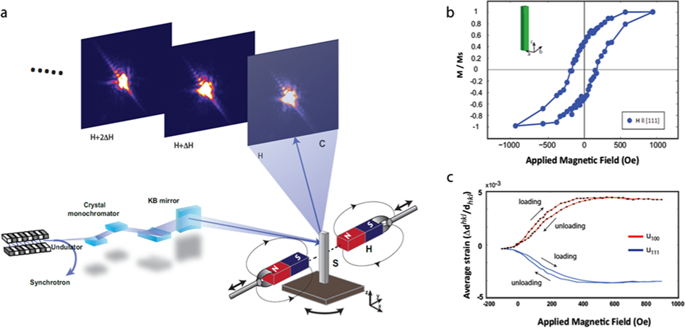NPG Asia Materials ( IF 8.6 ) Pub Date : 2019-10-18 , DOI: 10.1038/s41427-019-0160-8 Anastasios Pateras , Ross Harder , Sohini Manna , Boris Kiefer , Richard L. Sandberg , Stuart Trugman , Jong Woo Kim , Jose de la Venta , Eric E. Fullerton , Oleg G. Shpyrko , Edwin Fohtung

|
Abstract
Magnetostriction is the emergence of a mechanical deformation induced by an external magnetic field. The conversion of magnetic energy into mechanical energy via magnetostriction at the nanoscale is the basis of many electromechanical systems such as sensors, transducers, actuators, and energy harvesters. However, cryogenic temperatures and large magnetic fields are often required to drive the magnetostriction in such systems, rendering this approach energetically inefficient and impractical for room-temperature device applications. Here, we report the experimental observation of giant magnetostriction in single-crystal nickel nanowires at room temperature. We determined the average values of the magnetostrictive constants of a Ni nanowire from the shifts of the measured diffraction patterns using the 002 and 111 Bragg reflections. At an applied magnetic field of 600 Oe, the magnetostrictive constants have values of λ100 = −0.161% and λ111 = −0.067%, two orders of magnitude larger than those in bulk nickel. Using Bragg coherent diffraction imaging (BCDI), we obtained the three-dimensional strain distribution inside the Ni nanowire, revealing nucleation of local strain fields at two different values of the external magnetic field. Our analysis indicates that the enhancement of the magnetostriction coefficients is mainly due to the increases in the shape, surface-induced, and stress-induced anisotropies, which facilitate magnetization along the nanowire axis and increase the total magnetoelastic energy of the system.
中文翻译:

单晶镍纳米线中的室温巨磁致伸缩
抽象的
磁致伸缩是由外部磁场引起的机械变形的出现。通过纳米级的磁致伸缩将磁能转换为机械能是许多机电系统(例如传感器,换能器,致动器和能量收集器)的基础。然而,在这样的系统中,通常需要低温和大磁场来驱动磁致伸缩,从而使得该方法在能量上效率低下,并且对于室温设备应用而言是不切实际的。在这里,我们报告在室温下单晶镍纳米线中巨磁致伸缩的实验观察。我们使用002和111布拉格反射从测量的衍射图样的位移确定了Ni纳米线的磁致伸缩常数的平均值。100 = -0.161%和λ 111 = -0.067%,幅度比在块状镍较大的两个数量级。使用布拉格相干衍射成像(BCDI),我们获得了镍纳米线内部的三维应变分布,揭示了在外部磁场的两个不同值下局部应变场的成核现象。我们的分析表明,磁致伸缩系数的增加主要归因于形状,表面感应和应力感应各向异性的增加,这些各向异性促进了沿纳米线轴的磁化并增加了系统的总磁弹性能。











































 京公网安备 11010802027423号
京公网安备 11010802027423号